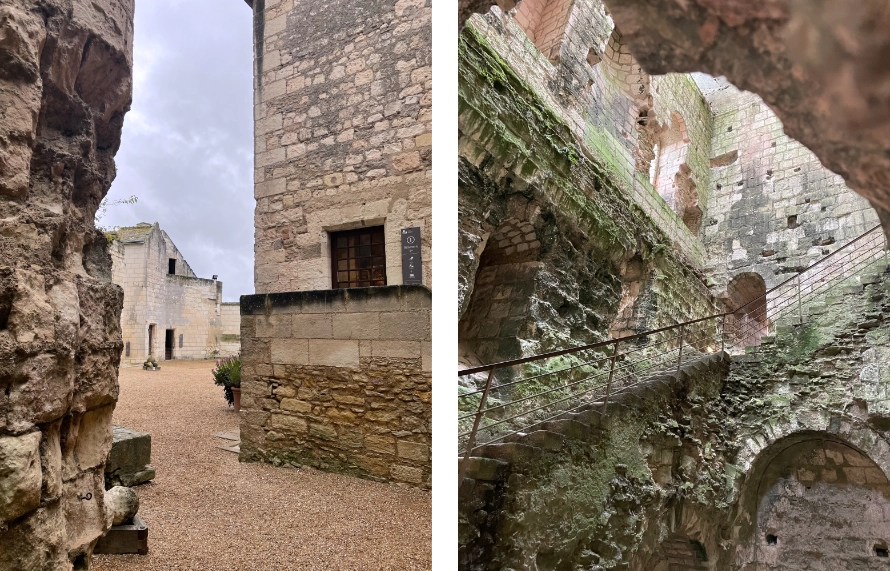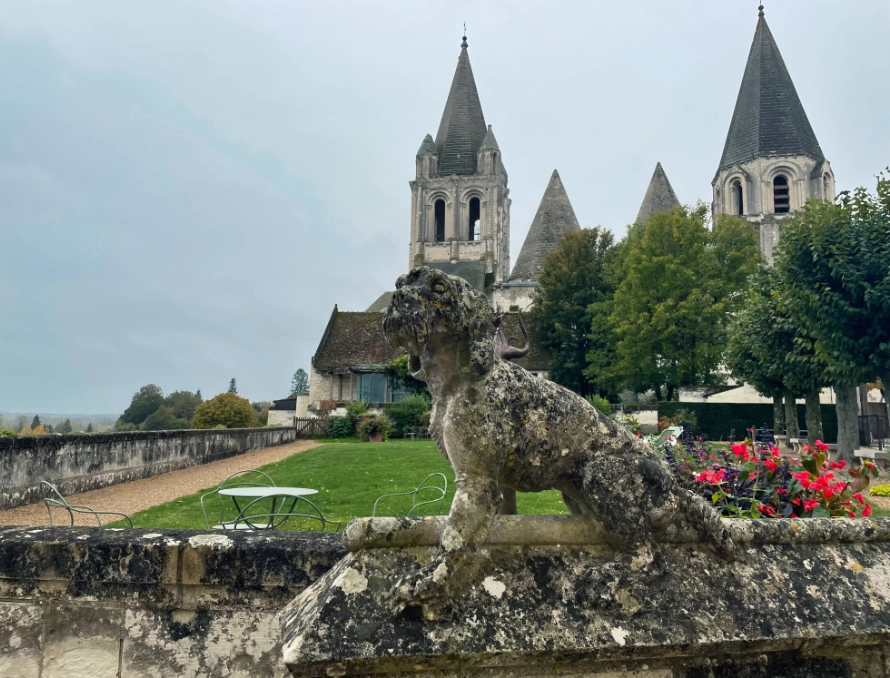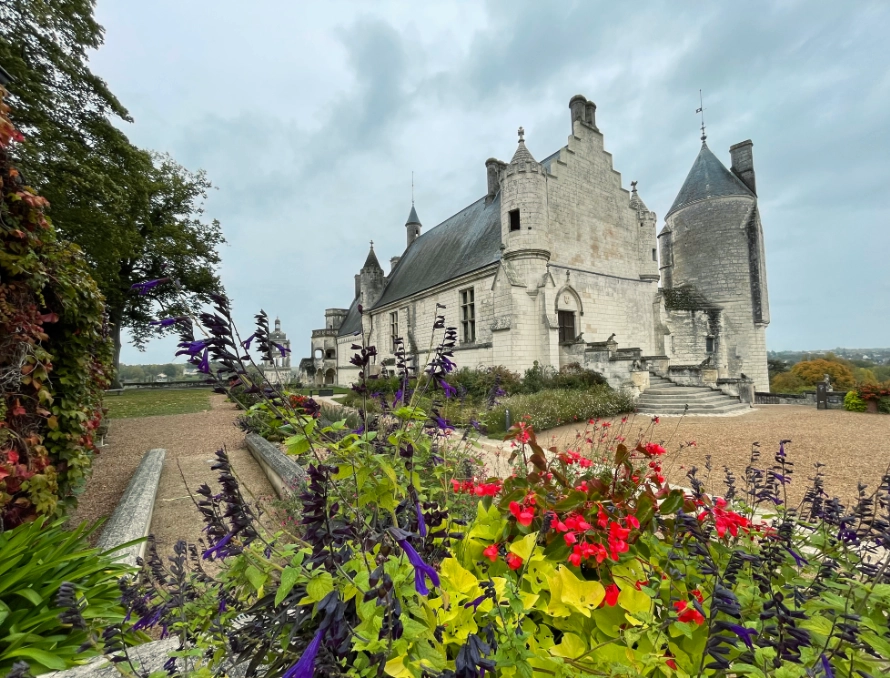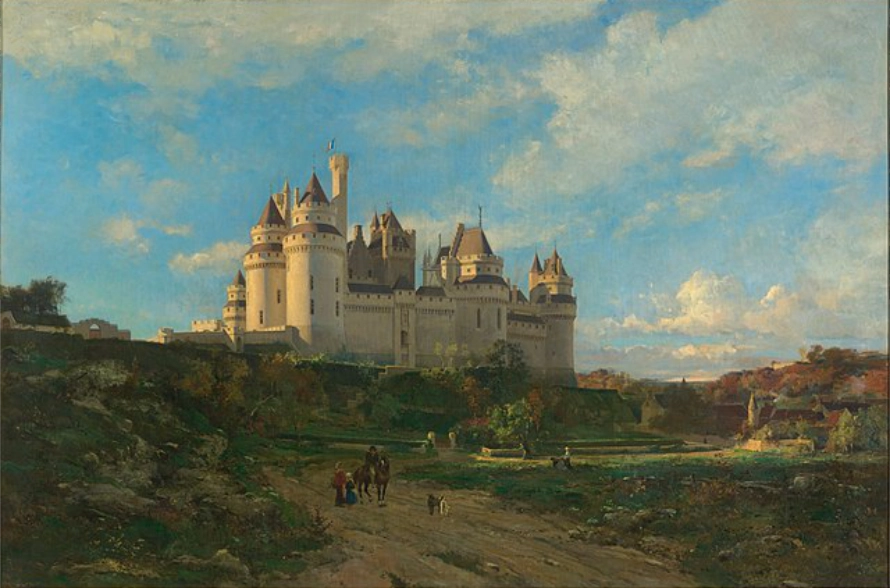The layers of Loches
Loches is the kind of place that makes you feel like you’ve found something special. It’s not the biggest town in the Loire Valley, and it doesn’t have the crowds you’ll see at Amboise or Chenonceau. Instead Loches offers a genuine taste of French history and daily life, all wrapped up in a setting that’s both impressive and easy to get around.
The town sits right in the middle of the Indre-et-Loire department, surrounded by rolling countryside and vineyards. The Indre River loops around it, and the old parts of town climb up the hillside towards the castle that’s been watching over the valley for nearly a thousand years.
We visited Loches in October, and while the skies were cloudy, the temperatures were still pleasant, perfect for exploring without the summer crowds or winter chill. Walking through the cobbled streets towards the castle, it was easy to see why Loches has been a favourite for travellers for centuries.

A town built on history
Loches has been important for a long time. It started as a monastery in the early Middle Ages, but it was the Counts of Anjou who really put it on the map. In the 11th century, Fulk III built the first big keep here, a fortress that still stands today, looking out over the town and the river. The keep is one of the best-preserved medieval fortresses in Europe, and it’s a good example of how Loches has always been a place people wanted to control.
By the 13th century, Loches had become a royal stronghold. The French kings took it from the English, and from then on it was a favourite spot for the court. Charles VII, Joan of Arc, and Louis XI all spent time here. The town’s location on the old route from Paris to northern Spain made it important for trade, and you can still see that history in the market square and the old Renaissance houses.
The castle welcomed some of the most famous figures in French history: Charles VII, Louis XI, Joan of Arc, and Agnès Sorel, the beautiful and influential mistress of Charles VII, whose tomb now rests in the collegiate church.
Loches was a military outpost but it was also a centre of trade, thanks to its position on the ancient route linking Paris to northern Spain. This commercial heritage is still visible today in the town’s bustling market square and the elegant Renaissance mansions that line its streets
The royal city: a fortress like no other
The heart of Loches is the Royal City. The keep is the main attraction, it’s over 40 metres tall, with thick walls and plenty of towers. Inside, you can climb up to the top for a view over the town and the countryside. There are dungeons, underground passages, and rooms where prisoners were once kept. It’s a serious piece of military architecture, and it gives you a good idea of what life was like for the people who lived and worked here centuries ago.

Next to the keep is the royal lodge. This is where Joan of Arc came to meet Charles VII in 1429, right after her victory at Orléans. She urged him to go to Reims and be crowned king, and he did. The lodge is also famous for its connection to Agnès Sorel, the mistress of Charles VII. Her tomb is in the collegiate church, and her portrait hangs in the royal apartments.
The collegiate church of Saint-Ours is another important part of the Royal City. It’s been here since the 10th century, and it’s got two pyramid-shaped domes that are pretty unusual for a church. The inside is full of carvings and stained glass, and it’s a peaceful place to stop and look around.

Agnès Sorel: beauty, power, and mystery
Agnès Sorel is one of the most interesting people in Loches’ history. She was born around 1422 and came to court as a lady-in-waiting to the queen. She wasn’t noble herself, but she was beautiful, intelligent, and ambitious. She became the first official royal mistress in French history, and she had a lot of influence over Charles VII.
But that’s not all, Agnès was more than just a pretty face (and a boob out!). She supported important people at court, like Pierre de Brézé and Jacques Cœur, and she encouraged the king to take action against the English in the Hundred Years’ War (Ahh, the endless war between the French and the English). She also introduced new fashions and helped promote the arts. Her nickname was the “Dame de Beauté” (Lady of Beauty), and she was famous for her style and her generosity.
Why one breast out you might wonder? That’s a fair question, and the honest answer is that the full story about Agnès Sorel and her exposed breast is a mix of fact, myth, and historical interpretation. If you’re intrigued, it’s worth exploring the history and art criticism around this striking portrait to get the full picture. Don’t forget to share your finds!

Agnès spent a lot of time in Loches, even when the king was away. She gave money to the church and made the town her home. She died in 1450, when she was only 28, and there are still rumours that she was poisoned. Charles VII was devastated and had her buried in the collegiate church, where her tomb is, a charming one may I say.
Today, Agnès Sorel is still a big part of Loches’ identity. Her story is told in museums and on guided tours, and her portrait is one of the most famous images from the period. She’s remembered as a woman of influence, style, and courage, not just as a royal mistress, but as someone who helped shape the history of the town and the country.

Art, culture, and everyday life
Loches is also a town of art and culture, with a lively market, charming boutiques, and a thriving community of artists. The town is officially recognised as a “Town of Art and History” and one of the “Most Beautiful Detours of France”, a title it more than lives up to.
One of my favourite spots is the Lansyer Museum, the former home of landscape painter Emmanuel Lansyer. The museum is a treasure trove of 19th-century art, with works by Lansyer and his contemporaries, as well as temporary exhibitions. The house itself is a time capsule, with period furnishings and a sense of intimacy that makes you feel like a guest rather than a visitor.
The town’s public gardens, especially the Saint-Louis garden and the gardens along the Indre River, are perfect for a leisurely stroll or a picnic. The views from the gardens over the town and the citadel are some of the best in Loches, and they’re a great place to relax after a morning of sightseeing

The market: a taste of local life
No visit to Loches is complete without a trip to the market. Held every Wednesday and Saturday morning, it’s one of the largest and most famous markets in the Loire Valley. The streets come alive with stalls selling fresh produce, artisan cheeses, local wines, and handmade goods. It’s a fantastic way to experience local life and sample the flavours of the region.
The market square is also home to a few excellent cafés and restaurants, where you can enjoy a coffee or a meal while watching the world go by. The atmosphere is friendly and unhurried, and it’s easy to spend a whole morning just soaking up the sights and sounds.
What to see and do in Loches
- The Royal City (Cité Royale de Loches)
Explore the 11th-century keep, one of the best-preserved in Europe, with its towers, dungeons, and panoramic views. Visit the royal lodge, where Joan of Arc met Charles VII and where Agnès Sorel’s tomb is located. And don’t miss the collegiate church of Saint-Ours, with its unique domes and beautiful carvings. - The Lansyer Museum
Discover the works of landscape painter Emmanuel Lansyer in his former family home, with period furnishings and temporary exhibitions. - The Market
Experience local life at the bustling Wednesday and Saturday market, with fresh produce, cheeses, wines, and handmade goods. - The Public Gardens
Relax in the Saint-Louis garden and the gardens along the Indre River, with stunning views over the town and citadel. - Historic Walking Trail
Follow the free walking trail map from the tourist office, passing landmarks like the Porte Picois (a 15th-century gateway), the Saint-Antoine tower (the town’s belfry), and Renaissance mansions. - Art and Architecture
Admire the town’s Renaissance buildings, including the Hôtel de Ville (town hall), the Chancellery, and the Centaur House. Visit the Saint-Antoine gallery, which houses two paintings attributed to Caravaggio. - Events and Festivals
Look out for special exhibitions at the royal lodge, Christmas markets, and cultural events throughout the year.
Practical information for visitors
- Getting There
Loches is about 2 hours 50 minutes from Paris by car, via the A10 and A85 motorways. - When to Visit
May to October offers the best weather, with warm summers and mild autumns. July and August are the warmest months, but also the busiest. Spring and early autumn are ideal for fewer crowds and pleasant temperatures. - Market Days
The market is held every Wednesday and Saturday morning. - Festivals and Events
Check the town’s calendar for special exhibitions, Christmas markets, and cultural events. - Accommodation
There’s a wide range of options, from modern hotels like the Brit Hotel Loches to charming historic hotels in the town centre. Many hotels offer free parking and are within easy walking distance of the main sights. - Guesthouses and B&Bs
For a more personal experience, consider staying in a guesthouse or B&B, many of which are located in historic buildings.

